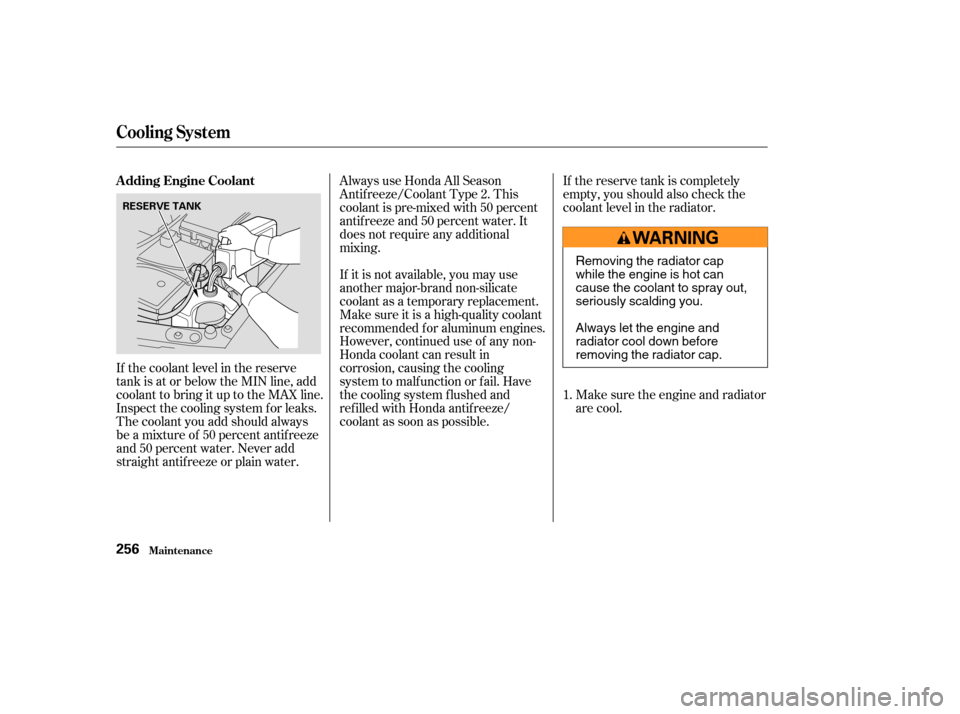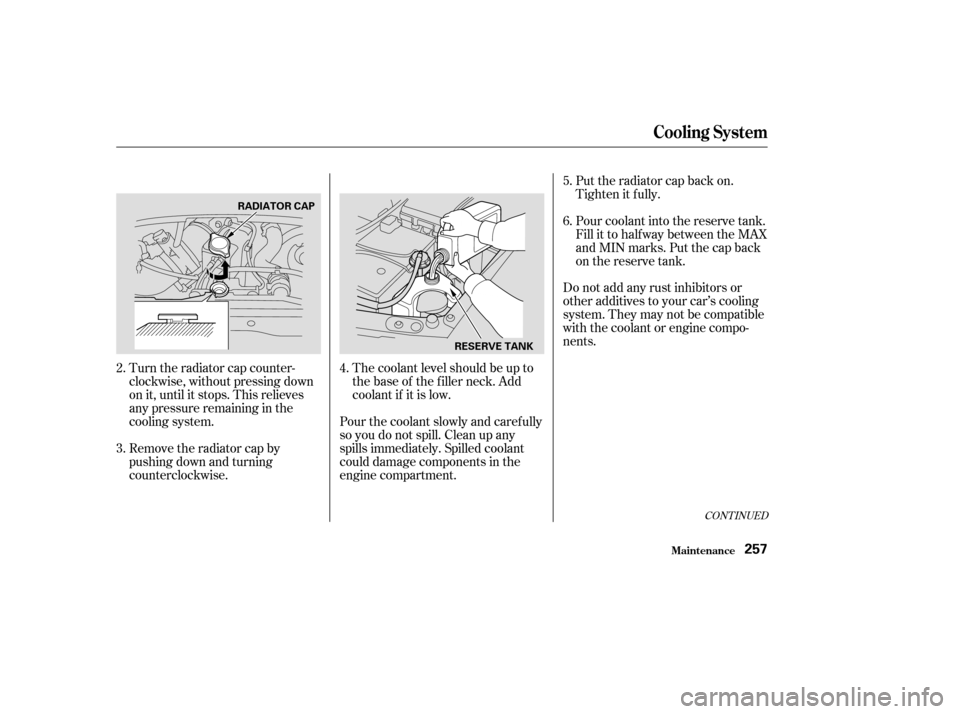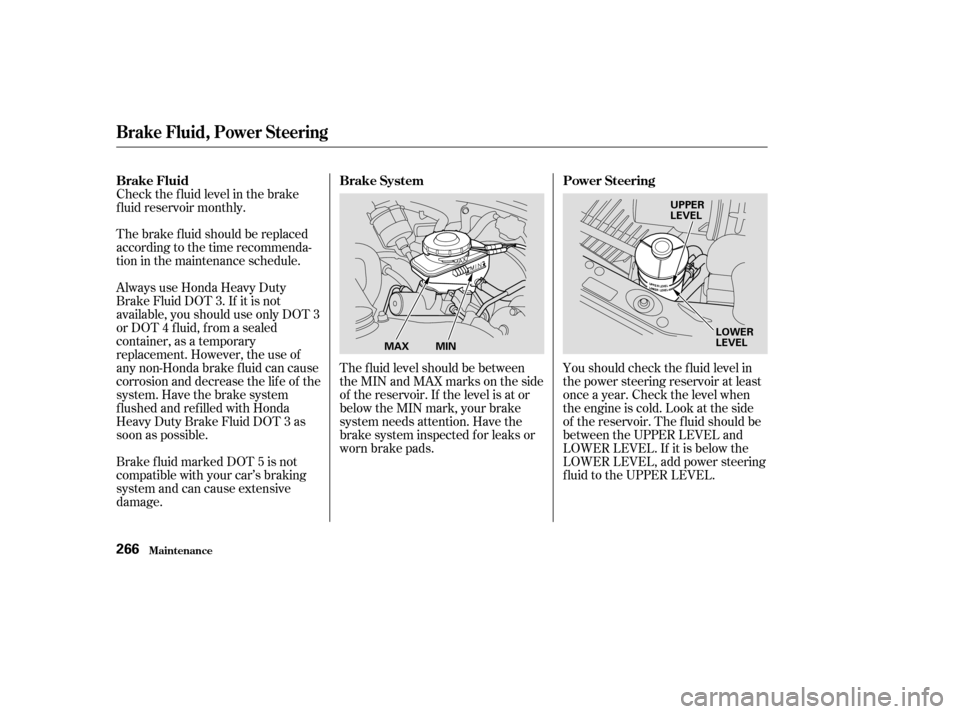engine Acura RL 2004 3.5 Workshop Manual
[x] Cancel search | Manufacturer: ACURA, Model Year: 2004, Model line: RL, Model: Acura RL 2004Pages: 370, PDF Size: 4.33 MB
Page 259 of 370

If the coolant level in the reserve
tank is at or below the MIN line, add
coolant to bring it up to the MAX line.
Inspect the cooling system f or leaks.
The coolant you add should always
be a mixture of 50 percent antif reeze
and 50 percent water. Never add
straight antif reeze or plain water.If the reserve tank is completely
empty, you should also check the
coolant level in the radiator.
Make sure the engine and radiator
are cool.
Always use Honda All Season
Antif reeze/Coolant Type 2. This
coolant is pre-mixed with 50 percent
antif reeze and 50 percent water. It
does not require any additional
mixing.
If it is not available, you may use
another major-brand non-silicate
coolant as a temporary replacement.
Make sure it is a high-quality coolant
recommended f or aluminum engines.
However, continued use of any non-
Honda coolant can result in
corrosion, causing the cooling
system to malf unction or f ail. Have
the cooling system f lushed and
ref illed with Honda antif reeze/
coolant as soon as possible.
1.
A dding Engine Coolant
Cooling Syst em
Maint enance256
RESERVE TANK
Removing the radiator cap
while the engine is hot can
cause the coolant to spray out,
seriously scalding you.
Always let the engine and
radiator cool down before
removing the radiator cap.
Page 260 of 370

The coolant level should be up to
the base of the f iller neck. Add
coolant if it is low.
Remove the radiator cap by
pushing down and turning
counterclockwise. Turn the radiator cap counter-
clockwise, without pressing down
on it, until it stops. This relieves
any pressure remaining in the
cooling system. Put the radiator cap back on.
Tighten it f ully.
Pour coolant into the reserve tank.
Fill it to half way between the MAX
and MIN marks. Put the cap back
on the reserve tank.
Do not add any rust inhibitors or
other additives to your car’s cooling
system. They may not be compatible
with the coolant or engine compo-
nents.
Pour the coolant slowly and caref ully
so you do not spill. Clean up any
spills immediately. Spilled coolant
could damage components in the
engine compartment.
2.
3.
4.5.
6.
CONT INUED
Cooling Syst em
Maint enance257
RADIATOR CAP
RESERVE TANK
Page 261 of 370

Loosen the drain plug on the
bottom of the radiator. The
coolant will come out through the
hole in the splash cover.
Turn the ignition ON (II). Turn
the heater temperature control
dial to maximum heat (climate
control to 90°F/32°C). Turn of f
the ignition. Open the hood. Make
sure the engine and radiator are
cool to the touch.
Remove the radiator cap.
Thecoolingsystemshouldbe
completely drained and ref illed with
new coolant according to the time
and distance recommendations in
the maintenance schedule. Only use
Honda All Season Antif reeze/
Coolant Type 2. Use of any non-
Honda coolant or plain water can
result in corrosion and deposits in
the cooling system.
Draining the coolant requires access
to the underside of the vehicle.
Unless you have the tools and
knowledge, you should have this
maintenance done by a skilled
mechanic.
1.
2.3.
Replacing Engine Coolant
Cooling Syst em
Maint enance258
DRAIN PLUG
Page 262 of 370

Remove the reserve tank f rom its
holder by pulling it straight up.
Drain the coolant, then put the
tank back in its holder.When the coolant stops draining,
tightenthedrainplugatthe
bottom of the radiator.
Put the drain cap back in place
tightly, then reinstall the clip on
the drain cap securely.
On the right side of the engine
block, remove the clip with a plier,
andthenremovethedraincap. 5.
4. 6.
CONT INUED
Cooling Syst em
Maint enance259
CLIP
RESERVE TANK
HOLDER
RESERVE TANK CAP
DRAIN CAP
Page 263 of 370

Remove the two bolts and the
three nuts with a 7/16 in (10 mm)
wrench, then remove the engine
cover.Loosen the bleeder bolt on top of
the engine.Pour Honda All Season
Antif reeze/Coolant Type 2 into
the radiator up to the base of the
f iller neck. This coolant is a
mixture of 50 percent antif reeze
and 50 percent water. Pre-mixing
is not required.
The cooling system capacity is:
Tighten the bleeder bolt when
coolant comes out in a steady
stream with no bubbles.
7. 8. 9.
10.
Cooling Syst em
Maint enance260
BLEEDER BOLT
BOLTS NUTS
1.61 US gal (6.1)
Page 264 of 370

Install the engine cover. First
tighten the two bolts on the front
of the engine cover, then tighten
the three nuts on the engine cover.
Tightening torque:
Install the radiator cap, and
tighten it to the first stop.
Start the engine and let it run until
the radiator cooling f an comes on
at least twice. Then stop the
engine.
Fill the reserve tank to the MAX
mark. Install the reserve tank cap.
Check the level in the radiator,
add coolant if needed. Remove the radiator cap. Pour
coolant into the radiator up to the
base of the f iller neck and into the
reserve tank up to the MAX mark.
Start the engine and hold it at
1,500 rpm until the cooling f an
comes on. Turn of f the engine.
Check the coolant level in the
radiator and add coolant if needed.
12. 11. 13.
14.
15. 16.
17.
CONT INUED
Cooling Syst em
Maint enance261
Fill up to here FILLER NECK
7 lbf·ft (9.8 N·m , 1.0 kgf·m)
Page 266 of 370

Fill the reservoir with a good-quality
windshield washer f luid. This
increases the cleaning capability and
prevents f reezing in cold weather.
Check the level in the windshield
washer reservoir at least monthly
during normal usage. In bad weather,
when you use the washers of ten,
check the level every time you stop
for fuel.
The windshield washer reservoir is
located behind the driver’s side
headlight.
Check the reservoir’s f luid level by
removing the cap and looking at the
f loat. It should be up to the top of the
neck.Ifthefloatisatthebottomof
the neck, the reservoir is nearly
empty. When you ref ill the reservoir, clean
the edges of the windshield wiper
blades with windshield washer f luid
on a clean cloth. This will help to
condition the blade edges.
Windshield Washers
Maint enance263
FLOAT
Do not use engine antif reeze or a
vinegar/water solution in the
windshield washer reservoir.
Antif reeze can damage your car’s paint,
while a vinegar/water solution can
damage the windshield washer pump.
Use only commercially-available
windshield washer f luid.
Page 267 of 370

Check the f luid level with the engine
at normal operating temperature.Remove the dipstick (yellow loop)
f rom the transmission, and wipe it
with a clean cloth. Insert the dipstick into the
transmission. Make sure the notch
in the rubber cap f its in the
dipstick guide and that you push
the dipstick in all the way.
Remove the dipstick and check
the f luid level. It should be
between the upper and lower
marks.If the level is below the lower
mark, add f luid into the tube to
bring it to the upper mark. Always
use Honda ATF-Z1 (Automatic
Transmission Fluid). If it is not
available, you may use a
DEXRON
III automatic
transmission f luid as a temporary
replacement. However, continued
use can affect shift quality. Have
the transmission f lushed and
ref illed with Honda ATF-Z1 as
soon as it is convenient.
To thoroughly f lush the
transmission, the technician
should drain and ref ill it with
Honda ATF-Z1 (Automatic
Transmission Fluid), then drive
the vehicle a short distance. Do
this three times. Then drain and
ref ill the transmission a f inal time.
Park the vehicle on level ground.
Shut of f the engine.
1.
2. 3.
4.5.
Automatic Transmission Fluid
Maint enance264
DIPSTICK
DIPSTICK GUIDE UPPER MARK
LOWER MARK
Page 269 of 370

The f luid level should be between
theMINandMAXmarksontheside
of the reservoir. If the level is at or
below the MIN mark, your brake
system needs attention. Have the
brake system inspected f or leaks or
worn brake pads.
Check the f luid level in the brake
f luid reservoir monthly.
The brake f luid should be replaced
according to the time recommenda-
tion in the maintenance schedule.
Always use Honda Heavy Duty
Brake Fluid DOT 3. If it is not
available, you should use only DOT 3
or DOT 4 f luid, f rom a sealed
container, as a temporary
replacement. However, the use of
any non-Honda brake fluid can cause
corrosion and decrease the lif e of the
system. Have the brake system
f lushed and ref illed with Honda
Heavy Duty Brake Fluid DOT 3 as
soon as possible.
Brake f luid marked DOT 5 is not
compatible with your car’s braking
system and can cause extensive
damage.
You should check the f luid level in
the power steering reservoir at least
once a year. Check the level when
the engine is cold. Look at the side
of the reservoir. The f luid should be
between the UPPER LEVEL and
LOWER LEVEL. If it is below the
LOWER LEVEL, add power steering
f luid to the UPPER LEVEL.
Brake System
Power Steering
Brake Fluid
Maint enance
Brake Fluid, Power Steering
266
MAX MIN UPPER
LEVEL
LOWER
LEVEL
Page 271 of 370

Place the new air cleaner element
in the air cleaner housing.
Reinstall the air cleaner housing
cover, snap the four hold-down
clamps back into place.
Remove the old air cleaner
element. Remove the air cleaner housing
cover. Do not disconnect the air
intake tube from the air cleaner
housing cover.
Unsnap the f our clamps holding
the air cleaner housing cover.
To replace it: The air cleaner element is inside the
air cleaner housing on the passenger’s
side of the engine compartment.
Caref ully clean the inside of the
air cleaner housing with a damp
rag.
1. 2.
3.
4.5.
6.
A ir Cleaner Element
Maint enance
Replacement
268
CLAMPS
AIR CLEANER
ELEMENT